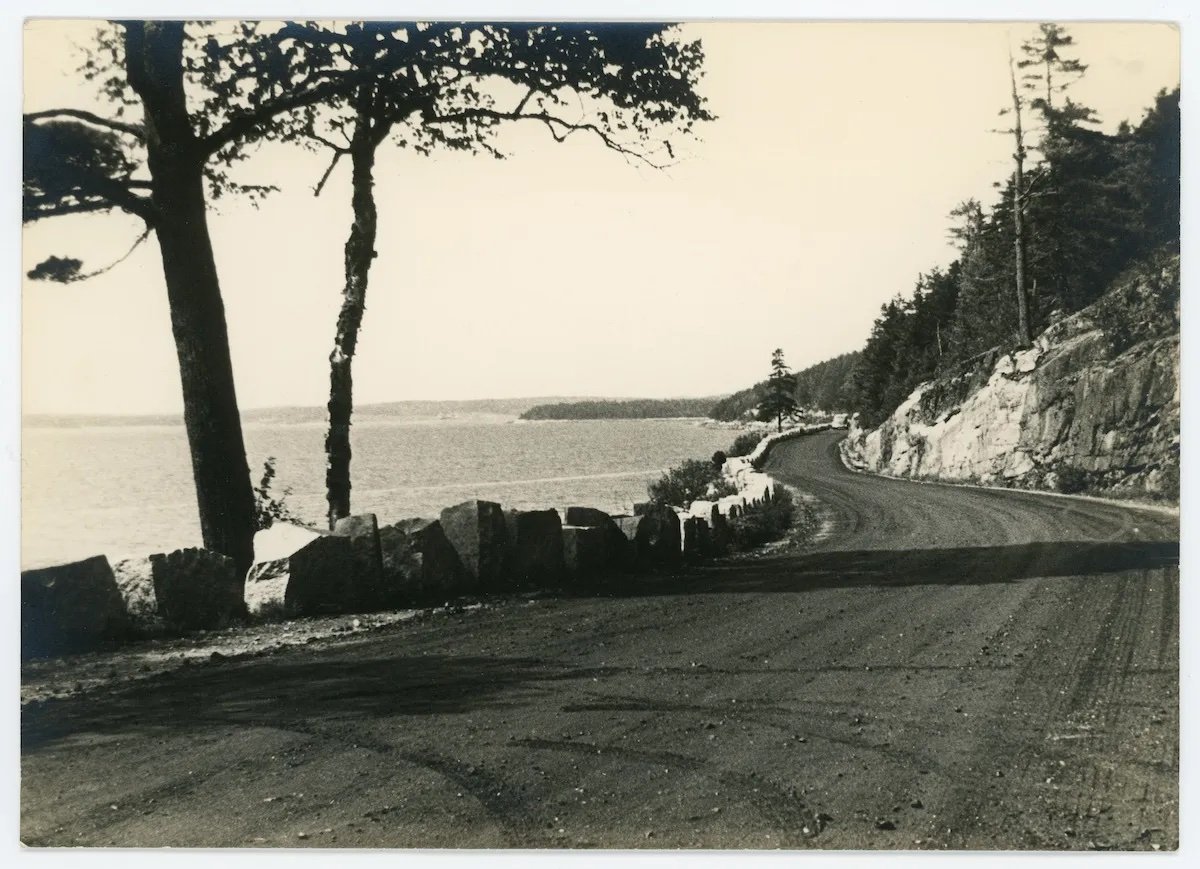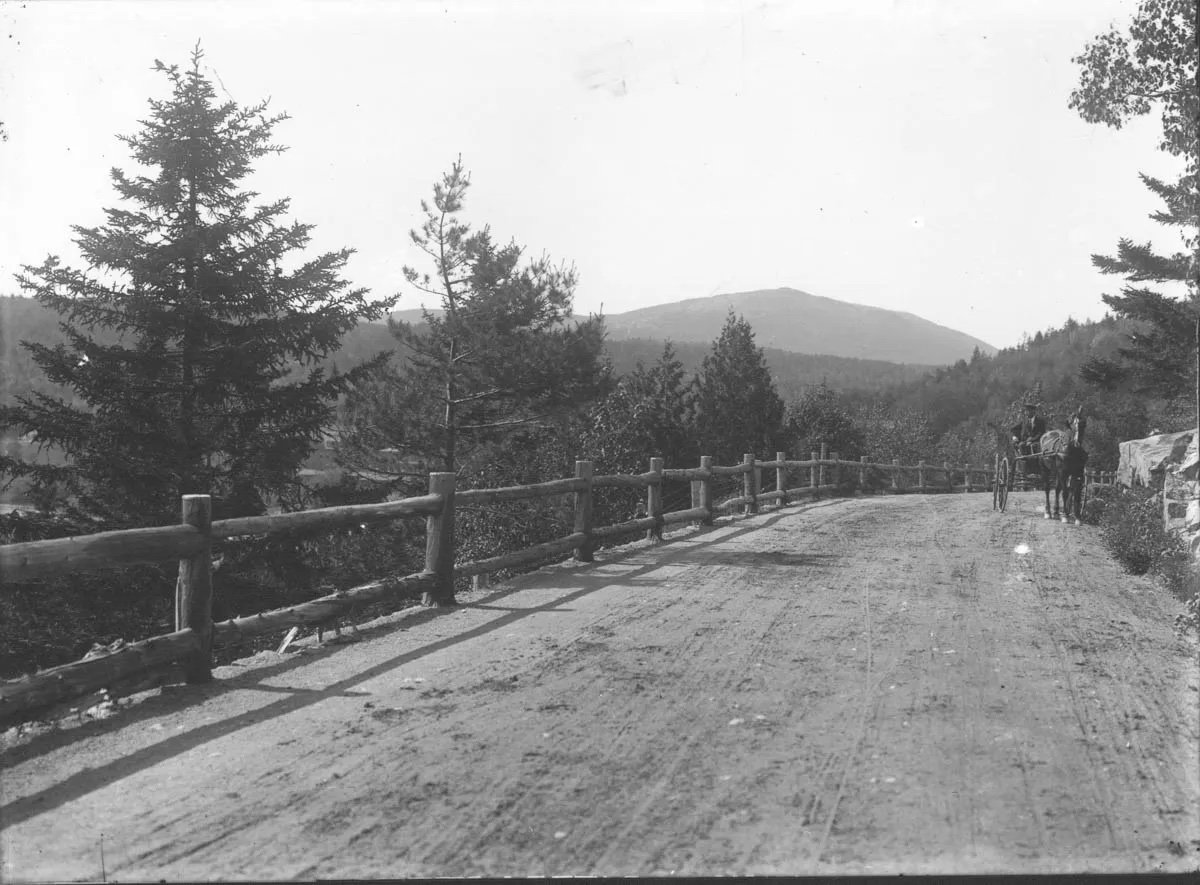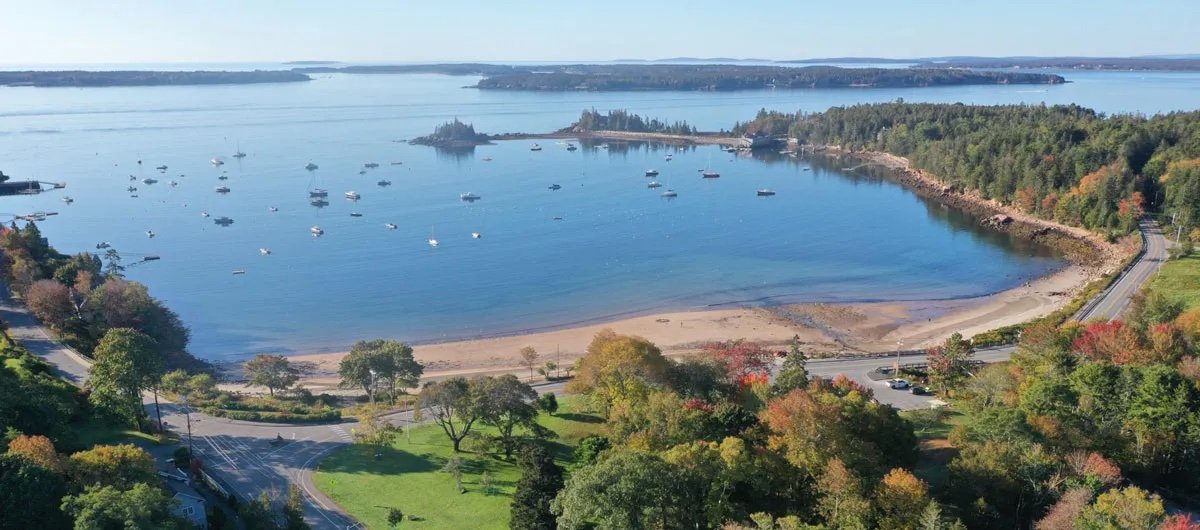Our Village Improvement Associations and Societies
September 27, 2022
By Eliza Worrick
Sargeant Drive as a dirt road in 1937. Constructed by the Northeast Harbor Village Improvement Society between 1897 and 1901 and named for Samuel Duncan Sargeant. Image courtesy of the Northeast Harbor Library.
“Will the Island of Mt. Desert become more beautiful and attractive or less so as the years pass? The answer depends upon us who, whether for twelve months or two, live upon the Island; and everyone who lives on it loves it and would do much to conserve its beauties.” While they were uttered nearly 100 years ago, Bar Harbor Village Improvement Association member William Lawrence’s words could just as easily be said today. The island’s beauty and its need to be protected is something that anyone who spends any amount of time here can agree upon.
It was this desire that inspired island residents in the late 19th and early 20th century to create the first local Village Improvement Associations, located in Bar Harbor (1881), Northeast Harbor (1898), Town Hill (1898), Seal Harbor (1900), and Southwest Harbor (1914). “The Village Improvement Societies of the Island have long been a common meeting ground for permanent and summer residents,” said landscape architect and one of Acadia National Park’s eventual founders Charles W. Eliot in his 1928 report to the Plan Committee of the Bar Harbor Village Improvement Association. “Through their activity a great benefit has resulted to both groups.”
Horse-drawn cart in July 1898 at the head of Sea Street in front of the old Manchester home. Image from Jeff Dobbs Productions courtesy of the Northeast Harbor Library.
While many of the issues they tackled were specific to each town or village (cultural events, sanitation, street maintenance, development of small parks, etc.), the associations came together to create the Joint Path Committee, which constructed and maintained about 250 miles of walking paths around the island. Much of this trail system is still in use today, such as Gorham Mountain’s Cadillac Cliffs Trail, the Seaside Path in Seal Harbor, and the entire Northeast Harbor trail system from the village up to Lower Hadlock Pond and to the Asticou Stream.
We also have the Village Improvement Societies (VIS) to thank for some of the beautiful roads we still drive our cars along today. First called “Sea Cliff Drive,” Cooksey Drive was developed by the Seal Harbor Village Improvement Society led by George Stebbins. Sargeant Drive, the best way to experience Somes Sound from land, was constructed by the Northeast Harbor Village Improvement Society between 1897 and 1901 at a cost of $10,929.73, equivalent to about $189,302.28 today.
Cooksey Drive in Seal Harbor. Date unknown. Photo courtesy of the Northeast Harbor Library.
As the impact of the Village Improvement Societies expanded, Charles W. Eliot approached their leadership towards the end of the 19th century with a proposal: to create an overarching organization with the sole purpose of “…acquiring, owning and holding lands and other property in Hancock County for free public use.” On September 12, 1901, the Hancock County Trustees of Public Reservations was created and then incorporated by the Maine Legislature in 1903. This organization helped pave the way for the creation of what we now know as Acadia National Park.
It must be mentioned that much of the early work done by the Village Improvement Societies, the Hancock County Trustees of Public Reservations, and Acadia’s founders to set aside land was often achieved by displacing blue-collar workers and their families and the Wabanaki people who had lived on the island for generations. Seasonal Wabanaki encampments were relocated and outright banned in places that these organizations wanted to use. As the National Park Service’s website explains, “The land buying activities often displaced working class citizens and in specific cases targeted people of color, particularly Native Americans, under the cover of sanitary improvements.” Readers are encouraged to learn more about the often untold stories of Acadia here.
Today, there are six Village Improvement Associations on the island. In the Town of Mount Desert, the Somesville Village Improvement Society and the Aid Society of Otter Creek have joined the list. All six associations/societies are 501(c)(3) nonprofit organizations. Pretty Marsh also has its Community Corporation, an events-based organization and “the last MDI Historic Community Organization still active,” according to their Facebook page. The scope and scale of each group vary from village to village, but the impact they all make is powerful.
As mentioned above, the Northeast Harbor VIS maintains a beautiful, often peaceful trail system within the village. As of 2019, they had completed major improvements to several trails, including the addition of granite steps and new signage. Their future plans involve clearing a vista on one trail and restoring an older path. While the Northeast Harbor VIS does not have an online presence, they accept contributions and suggestions at P.O. Box 722, Northeast Harbor, Maine, 04662.
Thaddeus Shepley Somes Memorial Bridge in Somesville. Image by Eliza Worrick.
Across the Sound, the Somesville VIS continues “with its mission to maintain the beauty of our village,” according to President Charles Lerner in the 2021 Town of Mount Desert Report. “This includes providing for the flower boxes on the Mill Pond bridge, highlighting the utility of the Thaddeus Shepley Somes Memorial Bridge via flag and wreath displays, and maintaining the flags and surrounding area at the 102/198 intersection.” Like the Northeast Harbor VIS, the Somesville VIS does not have an online presence, but they accept contributions at P.O. Box 53, Mount Desert, Maine, 04660.
Otter Creek Hall, managed by the Otter Creek Aid Society. Photo courtesy of the Society’s website.
Flags and memorials are part of the Aid Society of Otter Creek’s mission as well. They recently built a veterans memorial park across the road from Otter Creek Hall (formerly Otter Creek Church) on Route 3. The Aid Society maintains the Hall as a community and event center while also providing some support to Otter Creek residents in need. Most recently, the Aid Society has shifted some of its focus to where the village boundary meets with the Park Loop Road at the causeway in front of Otter Creek’s inner harbor. “They are considering how to increase tidal flushing so the inner cove can be returned as much as possible to its pre-rusticator state,” said John Macauley, the Aid Society’s Vice President. Built in 1938 by the U.S. Bureau of Public Roads, the causeway’s design “was to limit tidal flow to build a swimming pool,” said Town of Mount Desert Manager Durlin Lunt in a June 2022 update on the project. The Aid Society of Otter Creek is working with the Town of Mount Desert, Acadia National Park officials, a COA professor, and a scientist at the Schoodic Institute to look into ways to improve this natural area for wildlife and future generations.
Seal Harbor’s Village Green and Beach, both managed by the VIS. Photo courtesy of the Seal Harbor VIS’s website.
The Seal Harbor VIS oversees eight miles of paths, Seal Harbor Beach, and the Village Green. The Village Green was originally designed by famed landscape architect Beatrix Farrand in the early 20th century. In collaboration with the VIS, Farrand framed the green with maple trees to create a picturesque view of the harbor. About 100 years later, the VIS is still caring for this space by removing several of the maple trees that succumbed to disease and planting three new ones, according to VIS President Alex Stephens. “Farrand also designed the Dunham Overlook Garden near the Seal Harbor Fountain, which was beautifully restored last spring by the Garden Club of MDI along with a member of the VIS,” said Alex. The Seal Harbor VIS has four employees on its payroll: Larry Taylor, Chief Facilities and Grounds Manager, Deb Brown, Bookkeeper/Secretary, and Lisa Taylor (Larry’s wife) and Autumn Dellapietro, who assist Larry in maintaining the beach, green, and comfort station in the beach parking lot. Larry has worked for the Seal Harbor VIS for 38 years and can often be seen raking the beach in the early morning hours.
William Lawrence finished his 1928 statement to the Plan Committee of the Bar Harbor Village Improvement Association with a call to action: “The people of Mount Desert living throughout the year in the villages and farms, the keepers of shops and garages joining with those who come here for the summer can if we all will make this Island a unit of rare beauty…The carrying out of the program will take years; perhaps a century; the beginning of its execution is today.” Thanks in part to our Village Improvement Societies and Associations, this call is still being answered today.






